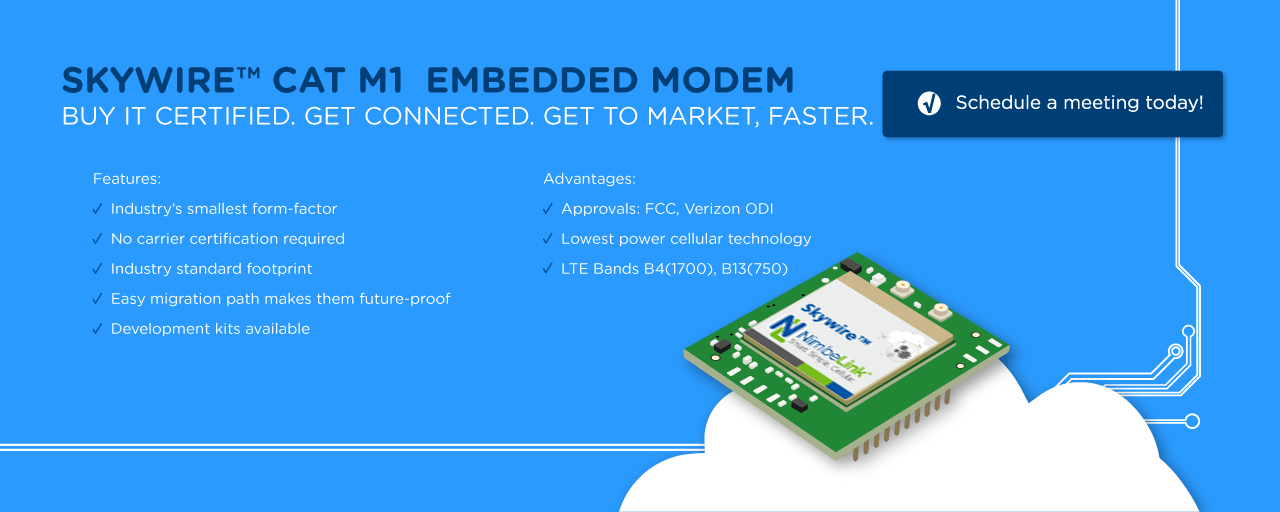- Home
- Symmetry Blog
- M1, Sigfox, and LoRa from Nimbelink
M1, Sigfox, and LoRa from Nimbelink
About Symmetry Electronics
Established in 1998, Symmetry Electronics, a Division of Braemac, is a global distributor of electronic components and systems. Combining premier components and comprehensive value-added services with an expert in-house engineering team, Symmetry supports engineers in the design, development, and deployment of a broad range of connected technologies.
Exponential Technology Group Member
Acquired by Berkshire Hathaway company TTI, Inc. in 2017, Symmetry Electronics is a proud Exponential Technology Group (XTG) member. A collection of specialty semiconductor distributors and engineering design firms, XTG stands alongside industry leaders TTI Inc., Mouser Electronics, and Sager Electronics. Together, we provide a united global supply chain solution with the shared mission of simplifying engineering, offering affordable technologies, and assisting engineers in accelerating time to market. For more information about XTG, visit www.xponentialgroup.com.
The Internet of Things (IoT) will never be a planned system.
It is growing organically and being shaped by millions of participants, applications, and technologies. While no one can predict just what it will look like as it grows, everyone agrees that it will be really big and that connectivity will be its lifeblood. That connectivity will take place at every scale, from a few feet over WiFi to thousands of miles on the cellular network. The messages its various nodes generate may be short or long, and they will range in frequency from very occasional to constant. They may be absolutely critical or able to tolerate occasional loss or delay to save money. And all those factors will help determine the form of connectivity any particular user chooses.
For some time now industry pundits have been discussing the future of networks in IoT applications including existing cellular, emerging Sigfox, and user-created LoRa.
To help find your best option for IoT connectivity, begin by asking simple questions about your need: what, when, where, and how.
- What is the nature and size of the messages you will be sending? Are they large or small, and is that size likely to change in the future. For messages requiring little bandwidth Sigfox or Lora might once have had an advantage over cellular. But with the advent of Cat M1 cellular technology within the LTE network, cellular modems can operate at extremely low power and lower cost, making them cost effective for small bandwidth applications as well as the higher-bandwidth applications served by other cellular modems such as Cat 3 and Cat 4.
- When will you roll out your application? In today’s highly competitive world, speed to market can be critical, and cellular is already in place and easy to access. Sigfox is in a fair number of places in Europe but just a few cities in the U.S. And LoRa won’t be ready until you or a third-party provider creates the necessary LoRa network where you need it. Cellular is already in place. If your answer to the “when” question is “now” or “soon,” cellular is your best bet.
- Where will your application need to operate? If Sigfox happens to be where you need it, it’s an option. LoRa can be anywhere you care to install it, but that creates some overhead, especially if you need to cover multiple discrete areas. Cellular is, essentially, everywhere. For low-bandwidth IoT data applications it even functions in areas where voice connectivity may be spotty.
- How reliable is the network, now and in the future? The biggest difference between cellular and the other options is that cellular uses licensed spectrum, which controls access and requires that accessing devices be certified. ; Sigfox and LoRa use unlicensed spectrum, which has no such controls leading to risk of overcrowding and interference.

Bottom Line, there won’t be one-size-fits-all solutions on the IoT, and there probably won’t be one dominant technology.
Your needs will change, markets will develop and change, and technologies will evolve. The crystal ball is still a little cloudy, so the question to ask is how much risk you can handle. Regarding any network you are considering for your IoT application:
- Is it where you need it?
- Will it be where you need it in the future?
- Is it set up to handle your current and anticipated needs
- Does it provide the reliability you require?
- Will it be able to withstand increasing traffic without degradation?
- Does it have a technology roadmap that fits your future needs?
- Will it be supported at an acceptable level?
- Are you sure, because your IoT application is absolutely dependent on connectivity?
At NimbeLink, we are regularly evaluating connectivity options and developing modems for those our customers can use.
Today those are cellular. If that changes, we will continue to develop and offer the technologies that best meet those needs. In the meantime, we are committed to helping power the explosive growth of the Internet of Things via the everywhere, always-on cellular network.
Source: http://nimbelink.com/blogs/m1-sigfox-lora/
